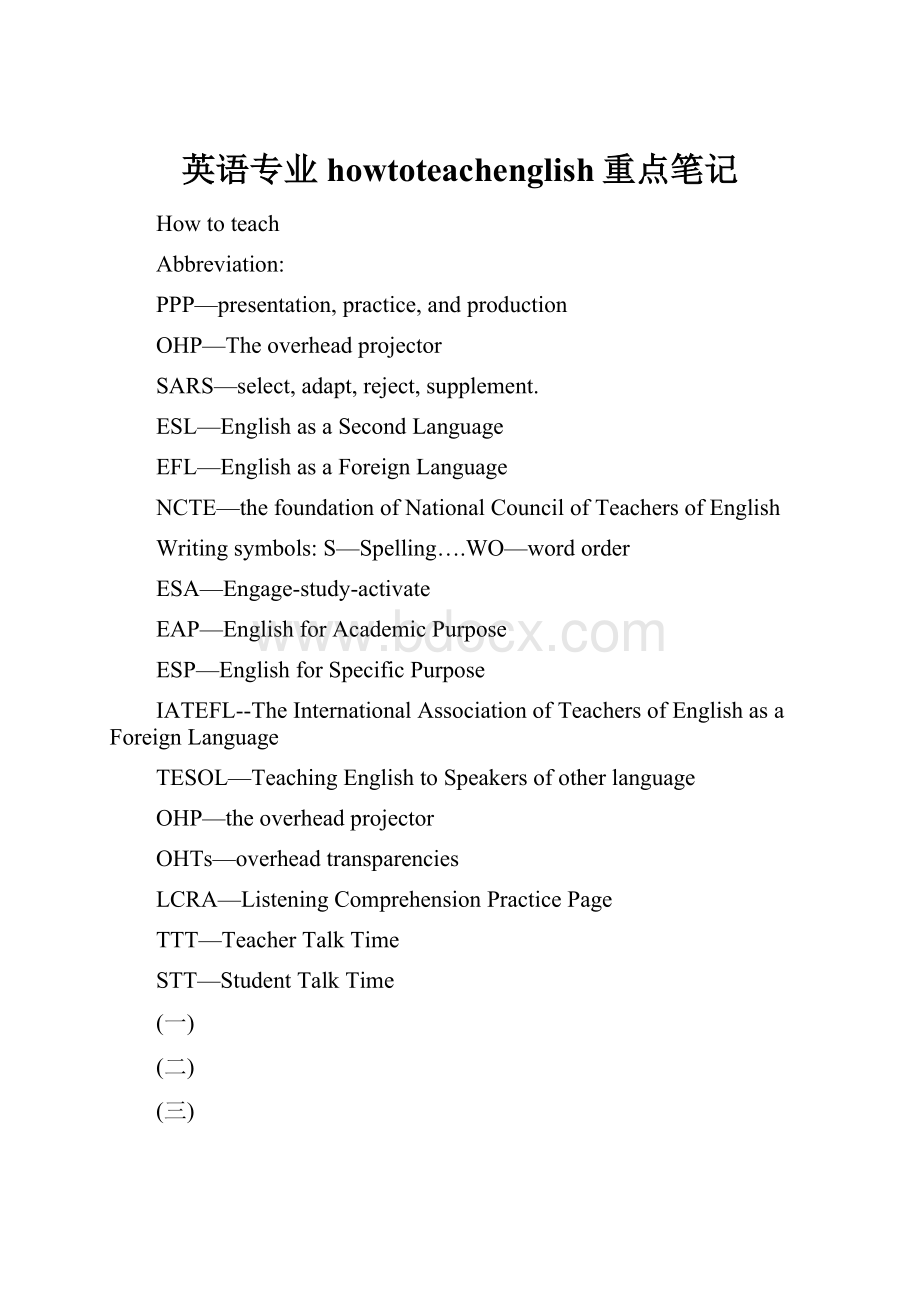英语专业howtoteachenglish重点笔记.docx
《英语专业howtoteachenglish重点笔记.docx》由会员分享,可在线阅读,更多相关《英语专业howtoteachenglish重点笔记.docx(10页珍藏版)》请在冰豆网上搜索。

英语专业howtoteachenglish重点笔记
Howtoteach
Abbreviation:
PPP—presentation,practice,andproduction
OHP—Theoverheadprojector
SARS—select,adapt,reject,supplement.
ESL—EnglishasaSecondLanguage
EFL—EnglishasaForeignLanguage
NCTE—thefoundationofNationalCouncilofTeachersofEnglish
Writingsymbols:
S—Spelling….WO—wordorder
ESA—Engage-study-activate
EAP—EnglishforAcademicPurpose
ESP—EnglishforSpecificPurpose
IATEFL--TheInternationalAssociationofTeachersofEnglishasaForeignLanguage
TESOL—TeachingEnglishtoSpeakersofotherlanguage
OHP—theoverheadprojector
OHTs—overheadtransparencies
LCRA—ListeningComprehensionPracticePage
TTT—TeacherTalkTime
STT—StudentTalkTime
(一)
(二)
(三)
(四)Informationgap (speakingactivity)wheretwospeakershavedifferentpartsofinformationmakingupawhole.Becausetheyhavedifferentinformation,thereisa‘gap’betweenthem.—onepopularinformation-gapactivityiscalled‘DescribeandDraw’.P88
(五)Information
(一)PrinciplesofTeachingListening
1) 1Thetaperecorderisjustasimportantasthetap
2) Preparationisvital
3) Oncewillnotbeenough
4) Studentsshouldbeencouragedtorespondtothecontextofalistening,notjusttothelanguage.
5) Differentlisteningstagesdemanddifferentlisteningtasks.
4.Varythematerialsintermsofspeakers'gender,age,dialect,accent,topic,speed,noicelevel,genre,
5.Alwaysaskstudentstolistenwithapurposeandallowthemtoshowtheircomprehensioninatask.
6.Languagematerialintendedtobeusedfortraininglisteningcomprehensionshouldneverbepresentedvisuallyfirst.
(二)PrinciplesofTeachingSpeaking
1) Beawareofthedifferencesbetweensecondlanguageandforeignlanguagelearningcontexts.
2) Givestudentspracticewithbothfluencyandaccuracy
3) Planspeakingtasksthatinvolvenegotiationformeaning.
4) Designclassroomactivitiesthatinvolveguidanceandpracticeinbothtransactionalandinteractionalspeaking.
(三)PrinciplesofTeachingreading
1) Readingisnotapassiveskill.
2) Studentsneedtobeengagedwithwhattheyarereading.
3) Studentsshouldbeencouragedtorespondtothecontentofareadingtext,notjusttothelanguage.
4) Predictionisamajorfactorinreading.
5) Matchthetasktothetopic.
6) Goodteachersexploitreadingtextstothefull.
7) Exploitthereader’sbackgroundknowledge.
(四)PrinciplesofTeachingWriting
1) Understandyourstudents’reasonsforwriting.
2) Provideopportunitiesforstudentstowrite–practicewriting.
3) Makefeedbackandcorrectionhelpfulandmeaningful:
over-correction
4) Clarifyforyourself,andforyourstudents,howtheirwritingwillbeevaluated.
(五) Threespecialfeaturesaboutteachinglistening
1) Tapesgoatthesamespeedforeverybody.
2) Studentshavetobeencouragedtolistenforgeneralunderstandingfirstratherthantryingtopickoutdetailsimmediately.
3) Spokenlanguagehasanumberofuniquefeatures.
(六) Fouraspectsthatshouldbeincludedinateachingplan.
1) Who–detailedinformationaboutthestudents.
2) What–whatdotheteacherandstudentswanttodo
3) How–howshouldtheteacherandstudentsdoit
4) Topredictwhatmightgowrongandhowitcanbedealtwith.
(七)FourTeachingmethodsandapproachesthathaveinfluencedthecurrentteachingpractice.
1) Grammar-translationmethod
2) Audiolingualism
3) Cognitiveapproach
4) Humanisticapproach
5) Communicativelanguageteaching
6) Task-basedteachingandlearning
(八)Fourdifferencesbetweenteachingadultsandteachingchildren
1) Motivation---Adultsarelikelytobeseekingeducationalsolutionstohelpthemgettowheretheywanttobeinlifewhichtheywillhavespecificallyoutlinedintheirmindspriortojoiningyourclass
2) Direction---Asaninstructoryoucanrelyonadultstobemoreself-directedthanchildrenwhowilldependonyouforfocusandsupport.
3) Trust---Adultsaremorelikelytobeskepticalaboutnewinformationandwillprefertotestouttheinformationbeforetheybelieveandacceptit.
4) Experience---Somethingtorememberisthatadultshavealottheycanbringtothetableandtheywillexpecttobeabletosharetheirlifeexperiencesandknowledgeinthelearningenvironment.
5) Feedback---Finally,adultswillbemoresensitivetoerrorsandwilltakeconstructivecriticismmorepersonally.
(九)Threereadingskillsthatstudentsneedtoacquireandexplaineachofthem.
1) Toscanthetextforparticularbitsofinformationtheyaresearchingfor.—thismeanstheydonothavetoreadeverywordandline;
2) Toskimatexttogetageneralidea.
3) Toreadfordetailedcomprehension.
Or
1) Scanning:
foraspecificfocus
Thetechniqueyouusewhenyou'relookingupanameinthephonebook:
youmoveyoureyequicklyoverthepagetofindparticularwordsorphrasesthatarerelevanttothetaskyou'redoing.
2) Skimming:
forgettingthegistofsomething
Thetechniqueyouusewhenyou'regoingthroughanewspaperormagazine:
youreadquicklytogetthemainpoints,andskipoverthedetail.It'susefultoskim:
Useskimmingwhenyou'retryingtodecideifabookinthelibraryorbookshopisrightforyou.
3) Detailedreading:
forextractinginformationaccurately
Whereyoureadeveryword,andworktolearnfromthetext.
Inthiscarefulreading,youmayfindithelpfultoskimfirst,togetageneralidea,butthengobacktoreadindetail.Useadictionarytomakesureyouunderstandallthewordsused.
(十)………………
(十一) Fourseatingarrangementsintheclass
1) Orderlyrows
T Theteacherandthestudentscanseeeachotherclearly.Disciplineandpersonal contactiseasy.
T Theteacherisworkingwiththewholeclassandeverystudentshouldbeinvolved.
T Onetrickthatmanyteachersuseistokeeptheirstudentsguessing.
2) Circles and horseshoes
T TheRoundTableLegend
T Afargreaterfeelingofequality
T Loweringthebarriers:
greateropportunitytogetclosetothestudents.
T Allthestudentscanseeeachotherandvariouscontactsareeasier.
3) Separatetables
T Itismucheasierfortheteachertoworkatonetablewhiletheothersgetonwiththeirownwork.
T Studentsmaynotalwayswanttobewiththesamecolleagues.
T Itmakes“whole-class”teachingmoredifficult,sincethestudentsaremoreseparated.
(十二) FourpiecesofequipmentthatyoucanmakeuseofinanEnglishclass.
T Theboard/thecomputer/thedictionary/theoverheadprojector/picturesandcards/thetaperecorder/theradioplaybackmachine/thevideocamera/
(十三) Twopopularinformation-gapactivities
DescribeandDraw
q Onestudenthasapicture.
q Thepartnerhastodrawthepicturewithoutlookingattheoriginal.
q Theonewiththepicturewillgiveinstructionsanddescriptions,andthe“artist”willaskquestionsanddraw.
q Itishighlymotivating,thereisarealpurposeforthecommunication(theinformationgap,completionofthetask),andalmostanylanguagecanbeused.Remembertoexchangethestudents’rolesiftheactivityisusedmorethanonce.
Story-tellingactivity
v Memorize
v Regroup
v Tellpicturesandformanewstory
Thefinalstoriesmaybedifferent.Thegroupstellthewholeclasswhattheirversionis,andtheteachercanfinallyre-showthepictures.
a) putthestudentsintofourgroups,callingthemA,B,C,D,andgiveoneofthefollowingpictures.Thegroupshavetomemorizeeverythingtheycanaboutthepictures—who’sinthem,what’shappeningect.
b) Theteachernowcollectsbackthepicturesandasksonestudentfromeachgroup(A,B,CandD)toformanewfour-persongroup.Theteachertellsthemtheyhaveseenadifferentpictureandasksthemtotalkwitheachotherandtellastory.—thetaskisforstudentstoworkoutwhatthestoryis.Theonlywaytheycandothisisbydescribingtheirpicturestoeachother.
c) Thefinalversionmaybedifferent.Thegroupstellthewholeclasswhattheirversionis.Theteachercanfinallyreshowthepicture.
Jigsawactivity
(十四) Threetypesofwritingrubrics
1) Non-weightedrubric:
Thistypeofrubricprovidesdescriptionsofwritingqualitybylevelacrossotherwritingcriteria.Abriefexampleofthistypeofrubricwouldlooklikethefollowing:
2) Weightedrubric:
Aweightedrubricissimilartotheunweightedone,butitbreaksthewritingskillsintocategoriesandsub-categories.Aspecificpointvalueisassignedtoeach.Convertingtheorganizationelementofthenon-weightedrubriconpage94intoanelementinaweightedrubricmight
3) Holisticrubric:
Aholisticrubricdescribesingeneraltermsthequalitiesofexcellent,good,fair,andunsatisfactoryassignments.Thesedescriptionscanbetiedtogradesorstandontheirown.Theinstructorthenchoosesthedescriptionthatfitstheassignment.Anexampleofonepartofaholisticrubricmightlooklikethis:
(十五) FouralternativesthatNevilleGrantsuggestswhentheteacherfindsthetextbookisinappropriate.
q Omission–firstly,heorshemightsimplydecidetoomitthelesson.
q Replacement–thesecondoptionistoreplacethetextbooklessonwithoneoftheteacher’sown.
q Addition–thirdistoaddactivitiesorexercisestowhatisinthebook.
q Adaptation—finalisfortheteachertoadaptwhatisinthebook.
(十六) Fourcharacteristicsofgoodlearners.
q Awillingnesstolisten-listentowhat’sgoingon.
q ..toexperiment:
many